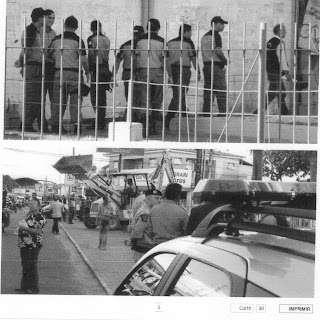BRAZIL ... THE PERCEPTION OF CHAOS?
We are at the threshold of a double catastrophe, that is, HUMAN AND ECONOMIC with the PANDEMIC OF THE CORONAVIRUS in something unprecedented to all humanity, but in our country, being in the context of IDIOCRACY, in which the priority is not HUMAN LIFE, but the ECONOMY IN WHICH IT IS SOMETHING DISPOSABLE. .. BUT WE GO TO THE PRECEDENTS OF HOW THE BRAZILIAN ECONOMY was before this pandemic ... our parameter will be the last meetings of COPOM (Organ governing the monetary policy of the Central Bank of Brazil) with the following points ...
- the prospect of a change in FOCUS THAT BEFORE the February 2020 meeting had the perspective of a recovery in the Brazilian economy, but in March 2020, with the EXOGENIC FACTOR of the CORONAVIRUS pandemic, this previous perspective changed radically
- The external sector still in February 2020, still anxious that the exogenous factor of the coronavirus would not be of an overwhelming magnitude for the world economy, but in March 2020, with the insertion by the WHO of the WORLD PANDEMY THE CHANGE OF 360 DEGREES IN THE CONTEXT FOR THE ECONOMY WORLD that is already going into a deep RECESSION
- THE DOUBLE VISION for the Brazilian economy of INFLATION will be stable but projects interest rates to rise as the interest rate is BELOW THE STRUCTURAL RATE
- STABILITY OF ADMINISTRATED PRICES (ELECTRICITY, WATER AMONG OTHERS)
INFLATION
The differences in the scenario for the contextualization of inflation between February and March 2020 is due to the fact that at the February 2020 meeting, the exogenous factor was UNDERESTIMATED, in which the analysis was concentrated on the UNDERLYING INFLATION (inflation that is implicit, that is, endogenous factors that "asleep") and leaves in the "AR" the exogenous risk factors such as PANDEMIA and its health and economic consequences.
The focus of there is HIGH OLEOSITY in the analysis of COPOM brings a prospective trajectory below the expected in an EXPANSIONIST MONETARY POLICY WITH INTEREST UNDER THE STRUCTURAL RATE brings lags that POTENTIALIZES INFLATION and in the view of NEOLIBERAL ANTI-SOCIAL reforms WERE THE REFORM THE PENSION REFORM.
The March 2020 COPOM meeting had a radical change because the PANDEMIC CORONAVIRUS underway around the world already brought its nefarious burdens in that it already brings the prospect of DEFLATION arising from the abrupt fall of the Brazilian economy AS A WHOLE AND WE HAVE THE FOLLOWING POINTS ...
- INCREASED UNCERTAINTY (EXPECTATIONS FLASH NEGATIVELY ´WITH THIS THE ECONOMY MAY EVEN LOCK)
- THE AGGREGATE DEMAND WILL HAVE AN OVERALL FALL
THE ABOVE GRAPHIC IS THE MOST GENERALIZED INFLATION IN BRAZIL
IS THE GRAPHIC BELOW IS THE BASIC RATE OF THE BRAZILIAN ECONOMY
According to the graph above, it illustrates monetary policy with the fall in interest rates between 2010 and 2019, when INFLATION fluctuated at a peak of 6.17% in the first half of 2015 and its lowest level of 1.11% in the second half of 2018. DEMONSTRATES the effectiveness of monetary policy in stopping the inflationary furor and from this to the CRISIS 2008 THE MONETARY EXPANSION jumped 47.47% between the years 2009 and the year 2000, since then it has passed 23% of GDP in the year 2000 to over 34% of GDP in 2009 and reaching its peak in early 2020 of almost 42% of GDP because the monetary base M2 which is the sum of MONEY IN HANDS of people the money that is in the banks so much in account current as in applications that brings a PARADOX IN THE HEADS OF NEOLIBERAL in its context of monetary retraction in conjunction with the rise in interest rates would bring LESS INFLATION .... in which it would be the NEOLIBERAL ideal in the following context below ...
A REDUCTION IN MONETARY OFFER SHIFTING UP THE LM CURVE
The PANEL (a) shows that, for any level of income Y, a reduction in the money supply increases the interest rate that balances the money market. Therefore. the LM curve, on the panel (b), moves upwards
COPOM IS IN CONTEXT WITH A FEAR OF UNDERLYING INFLATION DUE TO THE INFLATION CORE having the latency of factors causing inflation and can be triggered or not by exogenous shocks which we have to constantly monitor to avoid getting caught in "SHORT PANTS" "because the Brazilian economy is in the following macroeconomic conditions
- EXPANSIONIST MONETARY POLICY IN COMPARISON FROM THE YEAR 2000 TO THE BEGINNING OF THE YEAR 2020 OF 78.77%
- BASIC INTEREST RATE IN DECLINE FROM THIS JANUARY 2015 FROM 213% THAT PASSED FROM 11.75% TO 3.75 IN MARCH 2020
In this context, COPOM IS PERCEPTION that the basic interest rate is below the STRUCTURAL RATE of the economy is out of step between the monetary policy of having a monetary expansion and a declining basic interest rate ... see the graph below ...
THIS IS THE FIRST POSTS of a series that I will do to help everyone what is happening in Brazil ... please leave a nice comment ok



Comentários
Postar um comentário
OI é um blog de pelejar pelo social, aonde a exclusão social deve ser banida do nosso país e acabar a simbiose social.